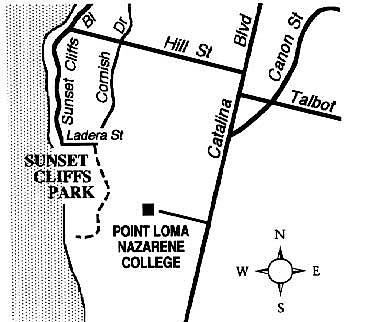 Facebook
Facebook
 X
X
 Instagram
Instagram
 TikTok
TikTok
 Youtube
Youtube
Sunset Cliffs Natural Park extends for some one and a half miles along Point Loma's ocean-facing side. The northern part covers only the cliffs that separate Sunset Cliffs Boulevard from the ocean. The remainder of the park includes a half-mile-long strip of coastline, plus some hillsides sloping upward toward the campus of Point Loma Nazarene College.
The natural erosion of the sea cliffs here proceeds at a geologically galloping pace -- thought to be dozens of feet per century. Elaborate retaining walls designed to dissipate wave energy have been installed to keep Sunset Cliffs Boulevard and nearby homes from being undermined. The wilder south end of the park is actually quite trampled and eroded due to many causes; among them encroachment on park land by playing fields and parking lots used by the college, and improper drainage. Nonetheless, you can spend a pleasant hour or two following the small, informal network of trails starting at Ladera Street and Cornish Drive. They can take you up and down the hillsides and out to the tops of the low cliffs, just above where the ocean waves splatter against water-worn boulders.
Near sunset on clear days, a golden glow settles across the ocean and cliff faces, and Sunset Cliffs Park becomes one of the best places to celebrate the day's end. At nearby Cabrillo National Monument you can't usually do this most of the year, since the monument closes too early in the afternoon.

Exploring tidepools is another favorite activity at Sunset Cliffs Park. Starting in October and ending in March, extreme low tides occur during afternoon hours -- not in the wee hours of the morning as in the spring and summer. During episodes of negative tides (that is, ocean water levels lower than the mean lower low tide), much of the intertidal zone is uncovered. Over the next two months, negative tides will occur during the afternoons of October 15 through 19, November 1 through 4, and November 13 through 18. Use the steep steps at Sunset Cliffs Boulevard and Ladera Street to reach the intertidal zone below. The tidepools there aren't the best for gazing at marine life, but it's fun to pick your way along the rocky shoreline beneath the banded cliffs.
Sunset Cliffs Park is great for kids, but little ones must be watched carefully. Most of the cliff edges are unfenced, and it's possible to slip on the hard-packed, eroded soil.

Sunset Cliffs Natural Park extends for some one and a half miles along Point Loma's ocean-facing side. The northern part covers only the cliffs that separate Sunset Cliffs Boulevard from the ocean. The remainder of the park includes a half-mile-long strip of coastline, plus some hillsides sloping upward toward the campus of Point Loma Nazarene College.
The natural erosion of the sea cliffs here proceeds at a geologically galloping pace -- thought to be dozens of feet per century. Elaborate retaining walls designed to dissipate wave energy have been installed to keep Sunset Cliffs Boulevard and nearby homes from being undermined. The wilder south end of the park is actually quite trampled and eroded due to many causes; among them encroachment on park land by playing fields and parking lots used by the college, and improper drainage. Nonetheless, you can spend a pleasant hour or two following the small, informal network of trails starting at Ladera Street and Cornish Drive. They can take you up and down the hillsides and out to the tops of the low cliffs, just above where the ocean waves splatter against water-worn boulders.
Near sunset on clear days, a golden glow settles across the ocean and cliff faces, and Sunset Cliffs Park becomes one of the best places to celebrate the day's end. At nearby Cabrillo National Monument you can't usually do this most of the year, since the monument closes too early in the afternoon.

Exploring tidepools is another favorite activity at Sunset Cliffs Park. Starting in October and ending in March, extreme low tides occur during afternoon hours -- not in the wee hours of the morning as in the spring and summer. During episodes of negative tides (that is, ocean water levels lower than the mean lower low tide), much of the intertidal zone is uncovered. Over the next two months, negative tides will occur during the afternoons of October 15 through 19, November 1 through 4, and November 13 through 18. Use the steep steps at Sunset Cliffs Boulevard and Ladera Street to reach the intertidal zone below. The tidepools there aren't the best for gazing at marine life, but it's fun to pick your way along the rocky shoreline beneath the banded cliffs.
Sunset Cliffs Park is great for kids, but little ones must be watched carefully. Most of the cliff edges are unfenced, and it's possible to slip on the hard-packed, eroded soil.
Comments